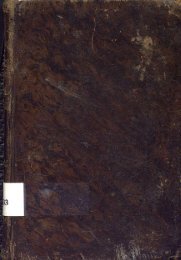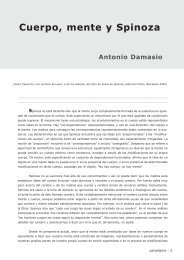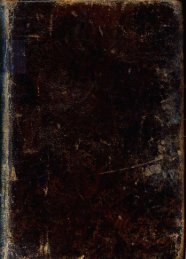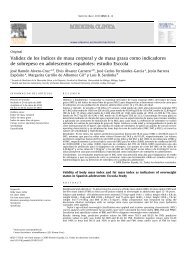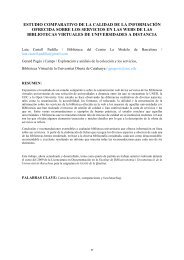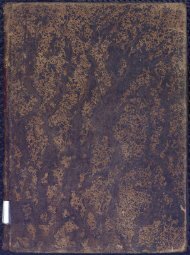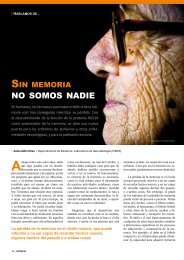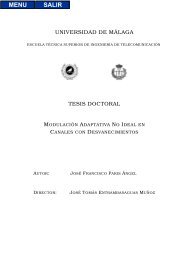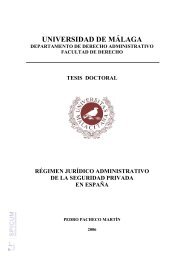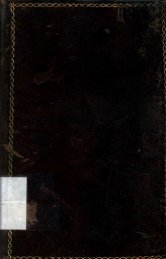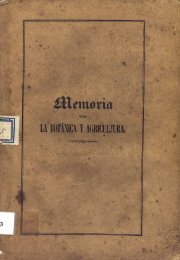Papel de las actividades superóxido dismutasa y catalasa en la ...
Papel de las actividades superóxido dismutasa y catalasa en la ...
Papel de las actividades superóxido dismutasa y catalasa en la ...
You also want an ePaper? Increase the reach of your titles
YUMPU automatically turns print PDFs into web optimized ePapers that Google loves.
Journal of Fish Diseases 2003, 26, 305–308<br />
PDíaz-Rosales et al. Resistance of Photobacterium damse<strong>la</strong>e to hydrog<strong>en</strong> peroxi<strong>de</strong><br />
Biological Sci<strong>en</strong>ce, Hiroshima University, Japan).<br />
Iso<strong>la</strong>tes were cultured in 250-mL f<strong><strong>la</strong>s</strong>ks containing<br />
100 mL of tryptic soya broth supplem<strong>en</strong>ted with 2%<br />
NaCl (TSBS) at 22° C until the early stationary<br />
phase (O.D. 600 nm ¼ 1.0). The effect of iron<br />
conc<strong>en</strong>tration on the cultures was evaluated in cells<br />
grown in TSBS supplem<strong>en</strong>ted with 2,2-dipyridyl<br />
(100 lm) or ferric chlori<strong>de</strong> (100 lm) according to the<br />
methodology <strong>de</strong>scribed by Barnes et al. (1999a).<br />
Bacterial survival against peroxi<strong>de</strong> after a pot<strong>en</strong>tial<br />
induction of cata<strong><strong>la</strong>s</strong>e by hydrog<strong>en</strong> peroxi<strong>de</strong> was tested<br />
according to Barnes, Bow<strong>de</strong>n, Horne & Ellis (1999b)<br />
by adding 20 lm hydrog<strong>en</strong> peroxi<strong>de</strong> to mid-expon<strong>en</strong>tial<br />
phase cultures and 2 mm hydrog<strong>en</strong> peroxi<strong>de</strong><br />
to early stationary phase cultures.<br />
Cells were harvested, washed and resusp<strong>en</strong><strong>de</strong>d in<br />
phosphate-buffered saline (PBS) to a <strong>de</strong>nsity of<br />
10 9 CFU mL )1 (O.D. 600 nm ¼ 1.00). Aliquots of<br />
100 lL were used to inocu<strong>la</strong>te 9.9 mL PBS containing<br />
hydrog<strong>en</strong> peroxi<strong>de</strong> at conc<strong>en</strong>trations of 0, 0.05,<br />
0.1, 0.5, 1 and 10 mm. Samples were incubated for<br />
1 h at 22° C and surviving bacteria were <strong>en</strong>umerated<br />
by viable counts on tryptic soya agar with 2% NaCl<br />
3 (TSAS) p<strong>la</strong>tes. The survival of H 2 O 2 -treated bacteria<br />
was expressed as the perc<strong>en</strong>tage of colony forming<br />
units recovered compared with untreated samples.<br />
An ANOVA test was performed to compare the<br />
results of the experim<strong>en</strong>ts.<br />
Previous studies with P. damse<strong>la</strong>e subsp. piscicida<br />
exposed to photochemically g<strong>en</strong>erated superoxi<strong>de</strong><br />
radicals show that bacterial inactivation is overcome<br />
wh<strong>en</strong> cata<strong><strong>la</strong>s</strong>e is ad<strong>de</strong>d to the medium (Barnes et al.<br />
1999b), thus indicating the important effect of<br />
hydrog<strong>en</strong> peroxi<strong>de</strong> on the inactivation of this<br />
bacterium. Results obtained in this study indicate<br />
that P. damse<strong>la</strong>e subsp. piscicida shows increased<br />
survival wh<strong>en</strong> exposed to peroxi<strong>de</strong> radicals wh<strong>en</strong><br />
cells have previously be<strong>en</strong> in contact with hydrog<strong>en</strong><br />
peroxi<strong>de</strong>. Both the virul<strong>en</strong>t and non-virul<strong>en</strong>t strains<br />
were inactivated after 1 h incubation with 10 mm<br />
H 2 O 2 , however, wh<strong>en</strong> <strong>de</strong>creasing conc<strong>en</strong>trations of<br />
peroxi<strong>de</strong> were used, a higher <strong>de</strong>gree of resistance to<br />
peroxi<strong>de</strong> was observed in the virul<strong>en</strong>t strain compared<br />
with the non-virul<strong>en</strong>t strain (Fig. 1).<br />
(a)<br />
Perc<strong>en</strong>tage of survival<br />
140<br />
120<br />
100<br />
80<br />
60<br />
40<br />
20<br />
(b)<br />
140<br />
120<br />
100<br />
80<br />
60<br />
40<br />
20<br />
0<br />
Perc<strong>en</strong>tage of survival<br />
0 0.05 0.1 0.5 1 10<br />
Peroxi<strong>de</strong> conc<strong>en</strong>tration (m M)<br />
Figure 1 Survival of Photobacterium<br />
damse<strong>la</strong>e subsp. piscicida, strains Epoy (a)<br />
and Lg41/01 (b) to exog<strong>en</strong>ous peroxi<strong>de</strong>.<br />
( )Stationary phase cultures; ( ) cultures<br />
treated at the mid-expon<strong>en</strong>tial phase with<br />
20 lm peroxi<strong>de</strong> followed by 2 mm peroxi<strong>de</strong><br />
in the early stationary phase; ( ) cells grown<br />
in TSBS with 100 lm 2,2-dypiridyl; ( )<br />
cells grown in TSBS with 100 lm ferric<br />
chlori<strong>de</strong>.<br />
Ó 2003<br />
B<strong>la</strong>ckwell Publishing Ltd<br />
306



